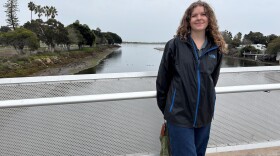“Stripper Energy,” a new six-part video podcast by KPBS, reveals a little-known San Diego civil rights story of dancers who fought back against corruption and abuses of power for decades from the unlikely stage of a strip club.
Former stripper and current owner of Les Girls Theater in San Diego’s Midway District, Kata Pierce-Morgan, is the main subject of the podcast and provides unlimited access to a half century of archival material, sharing intimate details of her experience in fighting back from the fringe of society to say “don’t be a silent bystander.”
Each chapter in the podcast focuses on a different aspect of Kata's decades-long fight and the history of Les Girls Theater. It starts with a look at stripper life from the 60s to the 80s, then explores how Les Girls was targeted for harassment after Kata's husband James Morgan refused to pay bribes and staged San Diego's first all-nude show. It goes on to chronicle the police abuse Kata and her fellow dancers suffered during the 1970s and 1980s, and the hard-fought reforms they finally won in the 1990s.
Creator and KPBS arts reporter Beth Accomando had been following Kata’s San Diego International Fringe Festival shows for seven years, slowly piecing together Kata’s experience. Beth approached Kata about taking part in a groundbreaking video podcast and she embraced the opportunity.
“Kata is not your typical social justice warrior; she is someone fighting for the marginalized within the marginalized community. Her story is a window into a group of women who suffered from police abuse and had no one to help. Their voices have not been heard. I wanted to tell their stories and make more people aware of what happened to them,” said Beth.
Public media’s purpose is to share the stories and experiences of all, particularly those who are marginalized and whose voices are ignored for a variety of reasons. “Stripper Energy” is the type of story that public media excels at - reminding us that we all matter.
“What I hope people take away from the video podcast is to not be a silent bystander. When you see abuse of power or corruption or harassment, you need to speak up, you need to tap into your stripper energy, get mad and fight back,” said Beth.
The chapters can be watched at kpbs.org/stripperenergy and on KPBS’ YouTube channel. Viewer discretion is advised for explicit content.
“Stripper Energy” chapter descriptions:
Chapter 1: Stripper Life, or Can You Handle the Naked Truth?
Do you know what stripper energy is? Let three women who worked as dancers at Les Girls Theater in San Diego expose you to the naked truth about what being a dancer was like in the 1960s, 70s and 80s. While dancers today may bristle at the term stripper, Kata Pierce-Morgan embraced it in the 1970s and fought against the stereotypes with what she calls “stripper energy.”
Chapter 2: Let It All Hang Out or How a Texas Baptist Went All-Nude to Shock San Diego
Kata’s life changed when she met James Morgan, a Texas Baptist Republican who challenged censorship and police abuse of power. Both Kata and Jim refused to be silent bystanders and that had consequences. Find out how a raid on Jim’s Left Bank establishment led to him opening Les Girls Theater and staging what was referred to as “The Censorship Play.”
Chapter 3: Climate of Fear, or What Happens When You Poke the Bear
Les Girls Theater scored a victory in the censorship battle but that only intensified an escalating war with the police who found new ways to harass the Les Girls dancers. They routinely endured a climate of fear as vice cops would arrest them but not file charges.
Chapter 4: Vice Grip, or the Rise of the Rat Pack
The police harassment of dancers that started in the 1970s, continued in the 1980s and began to extend outside of the venue of Les Girls Theater and into their homes and public places.
Chapter 5: Fighting Back, or the Rise of Stripper Energy
Kata left Les Girls in the late 1970s to go back to school but returned in the 1980s after the police harassment had intensified. She had a new-found maturity that gave her the confidence to fight back. She had cameras installed at Les Girls Theater so she could document how vice officers were behaving and disprove allegations against the dancers. Kata also developed a friendship with Capt. Lesli Lord, the first woman officer in charge of vice at the San Diego Police Department.
Chapter 6: Fringe Women, or How Art Can Heal
Kata has rediscovered her “stripper energy” by turning the history of Les Girls Theater into avant garde shows for San Diego International Fringe Festival. We go behind the scenes of this year’s “No Regrets” to discover how Kata and other Fringe artists are using art to heal, fight stereotypes and overcome trauma.
“Stripper Energy” is produced by the KPBS Digital Fellowship, a grant-funded program at the public media station. The Digital Fellowship provides an opportunity for KPBS journalists to spend three to four months developing an in-depth project on a digital-first platform, such as: podcasts, YouTube videos, interactive web features and social media. In addition to learning digital-first skills that are crucial to KPBS' future audience growth, digital fellows also do direct community engagement through listening tours and other events.
Press contact:
Heather Milne Barger
hmilne@kpbs.org




